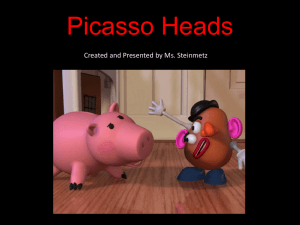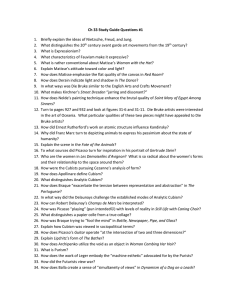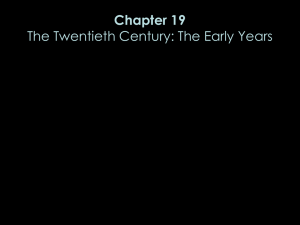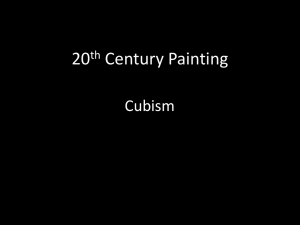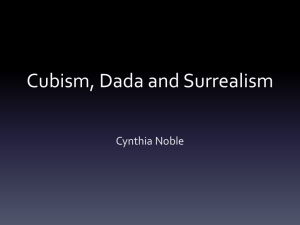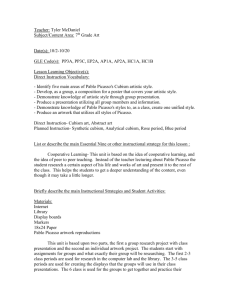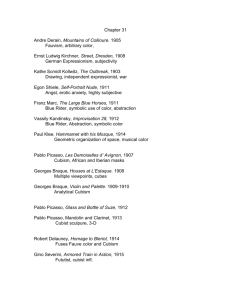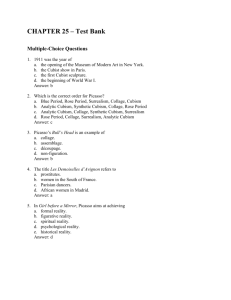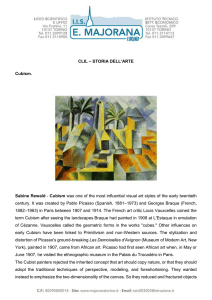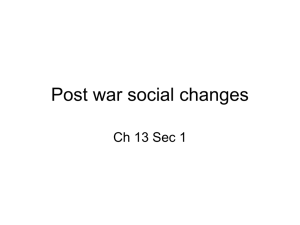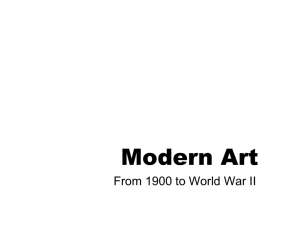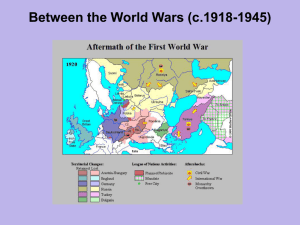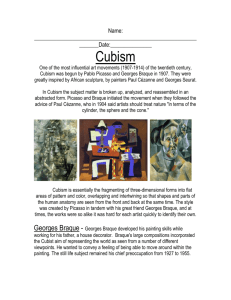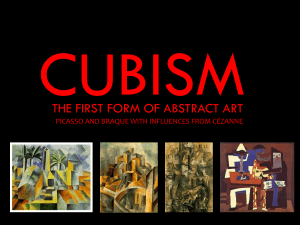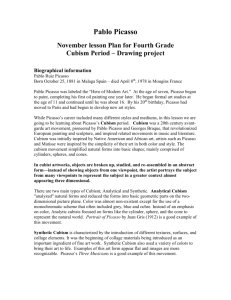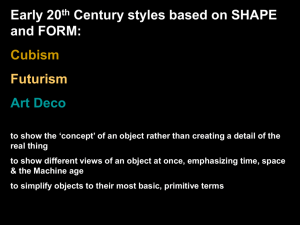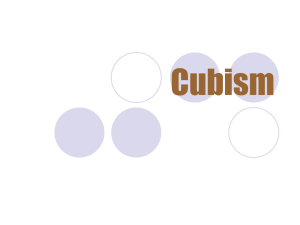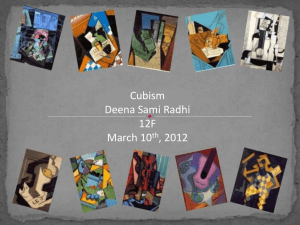Henri Matisse. Le Bonheur de Vivre (The Joy of Life).
advertisement
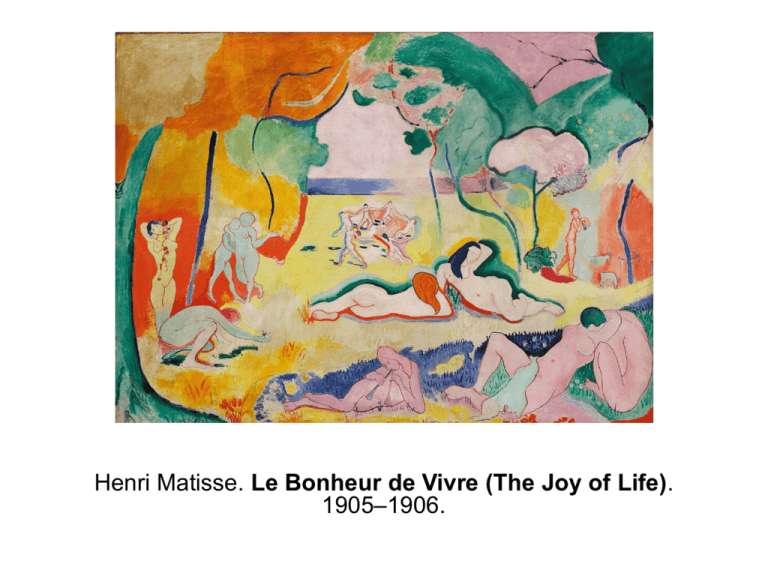
Henri Matisse. Le Bonheur de Vivre (The Joy of Life). 1905–1906. Ernst Ludwig Kirchner. Street, Berlin. 1913. 47 1/2 × 35 7/8‖. Vassily Kandinsky. Improvisation 28 (Second Version). 1912. 43 7/8 × 63 7/8‖. Analytic Cubism Pablo Picasso. Portrait of Daniel-Henry Kahnweiler. 1910. Synthetic Cubism Pablo Picasso. Glass and Bottle of Suze.1912. Umberto Boccioni, Unique Forms of Continuity in Space. 1913 Russian: Cubo-Futurism, Seprematist Kazmir Malevich, Seprematist Painting (8 red rectangles). 1915 COLLAGE and PHOTOMONTAGE The first collage was created by Pablo Picasso in 1908 at the age of 26. He created The Dream, which was an ink drawing on newsprint with a piece of paper from a department store advertisement attached to the drawing with white gauche, on the paper was another small drawing of a female fisherman. This was in essence the first time anyone had used a found object from everyday life and attached it to an artwork, thus the first collaged work. Pablo Picasso: Bottle of Vieux Marc, Glass, Guitar and Newspaper, 1913 Georges Braque: Violin and Pipe, 1913 Jean (Hans) Arp: Collage with Squares Arranged According to the Laws of Chance. (1916-17) Raoul Hausmann: ABCD, (self-portait), 1923-24 Hannah Hoch: Cut with the Dada Kitchen Knife through the Last Weimar Beer-Belly Cultural Epoch in Germany, 1919 Robert Rauschenberg: Charlene, 1954 Richard Hamilton: Just What Is It that Makes Today's Homes So Different, So Appealing?, 1956 Alexander Rodchenko: 1920 & 1919 Hugo Ball performs Karawane, a sound poem based on pure sound and the unspoken word. A critical avoidance of language, language spoiled by the lies and excesses of journalism and advertising Art should appeal to the mind rather than the senses! Marcel Duchamp’s Fountain signed R. Mutt from 1917 NYC ―Readymade‖ rejected for not being art. ―The only works of art America has ever given are her plumbing and bridges.‖ Duchamp ―Whether Mr. Mutt with his own hands made the fountain or not has no importance. He CHOSE it. He took an ordinary article of life, placed it so that its useful significance disappeared under the new title and point of view—created a new thought for that object.‖ El Lissitzky. Proun Space, 1923. (exhibition installation) Piet Mondrian. Composition with Yellow, Red, and Blue, 1927. Gerrit Rietveld. Red-Blue Chair for Schroder House, 1925. Gerrit Rietveld. Schroder House, 1925. Exam II Review: Take Next Week: 12 Points: Matching Terms 1. Les Fauves: ―Wild Beasts‖ French art movement used bright colors and contour lines, expressive freedom 2. Die Bruke: ―The Birdge‖ German art movement, explored the contradictions between progressive modern society and immoral primitivism in society. 3. Der Blaue Reiter: ―The Blue Rider‖ based on the Russian symbol of the Blue Knight. German art movement started by Kandinsky, he wondered if painting could work without a subject, it explored music as inspiration for improvising painted abstraction 4. Cubism: Picasso and Braque invented abstraction of objects and subjects of art 5. Synthetic Cubism: 3D-ish, collage, mixed-media art surfaces 6. Analytic Cubism: 2D used drawing materials on flat art surfaces 7. Futurism: Italian art movement based on modern machines, speed, masculinity, and violence. They were against all things old, safe, and feminine. 8. Cubo-Futurism: Russian art movement based on Cubist abstracted shapes and bright forceful Futurist styled compositions 9. Dada: European art movement, Hugo Ball & Tristan Tzara, Anti-WWI, anti-art, playful, fun, absurd. Dada radically changed what art could be. It began new possibilities for art. 10. Constructivism: Russian art movement, inspired by Cubism and Kazimir Malevich abstraction. It was an art and design movement that worked towards constructed abstraction in painting and sculpture related to De Stijl. 11. De Stijl: ―The Style‖ Dutch art & design movement toward pure art based upon Piet Mondrian’s paintings 12. Bauhaus: German architecture, art and design movement developed inspired by Constructivism and De Stijl work. Function is more important than form—how things operate is more important than how they look—the look of function can be nice looking!!!! 8 Points: Identify the Styles There will be 8 artworks and you must label the styles of each. 10 Points: Essay Discuss 2 artworks What are the artist’s names. What is the style being used? Describe why this style is important. Describe how the style was invented (was it a reaction to something?).

